LED Grow Lights Demystified: Efficacy (umol/j) vs. PPF (w) Explained
LED Grow Lights Demystified: Efficacy (umol/j) vs. PPF (w) Explained
In the world of indoor gardening and commercial horticulture, LED grow lights have revolutionized how we provide essential light to plants. The benefits of using LED technology for plant growth are numerous, including energy efficiency, longer lifespan, and the ability to tailor the light spectrum to the specific needs of plants. However, with the advent of this technology comes the necessity to understand its various metrics and terms, notably efficacy (umol/j) and Photosynthetic Photon Flux (PPF, measured in watts). These terms are critical for anyone looking to optimize their plant growth environment, yet they often cause confusion among both hobbyists and professionals alike.
Understanding the nuances of efficacy and PPF is not just about diving deep into the technicalities; it’s about unlocking the full potential of LED grow lights for healthier plants and more abundant yields. Efficacy, measured in micromoles per joule (umol/j), tells us how efficiently a grow light converts electrical energy into photosynthetically active radiation (PAR) that plants can use. On the other hand, PPF measures the total amount of PAR that a grow light produces per second, offering insight into the light’s overall output without directly indicating its efficiency or how well plants will use it.
This article aims to demystify these key terms, providing a clear understanding of what they mean, why they matter, and how they should influence your decisions when choosing LED grow lights. By comparing efficacy (umol/j) and PPF (w), we will explore how these metrics interact, their impact on grow light performance, and offer practical tips for making informed decisions. Whether you’re setting up a small home garden or managing a large-scale commercial grow operation, understanding these metrics will enable you to create the optimal lighting environment for your plants, ensuring robust growth and maximized yields.
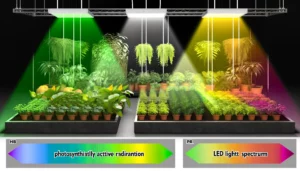
Introduction to LED Grow Lights and Key Terms
In the burgeoning world of indoor farming and precision horticulture, LED grow lights stand out as a beacon of innovation, offering a sustainable and efficient solution to simulate the sun’s spectrum. These lights have become indispensable tools for gardeners and commercial growers alike, enabling year-round cultivation of plants by providing a consistent and controlled light source. Understanding the key terms associated with LED grow lighting, such as Photosynthetic Photon Flux (PPF) and efficacy (umol/j), is crucial for leveraging this technology effectively.
Why LED Grow Lights?
The shift towards LED grow lights from traditional lighting solutions like HID or fluorescent lamps is driven by their superior energy efficiency, longevity, and the ability to customize the light spectrum to fit specific plant growth stages. LEDs can be tuned to emit narrow wavelengths of light, targeting the specific absorption peaks of chlorophyll and other photoreceptors in plants. This capability not only enhances photosynthesis but also allows for the manipulation of plant morphology, flowering, and fruiting times.
Understanding Key Terms
-
- Photosynthetically Active Radiation (PAR): This refers to the range of light wavelengths (400-700 nanometers) that plants are able to use for photosynthesis. Not all light emitted by a source falls within this range, making it a critical metric for evaluating grow light effectiveness.
- Photosynthetic Photon Flux (PPF): Measured in micromoles per second (umol/s), PPF indicates the total amount of PAR that a lighting system emits per second. It’s a measure of the light output relevant to plant growth, without considering the distribution or efficiency of that light reaching the plant canopy.
- Efficacy (umol/j): Efficacy is a measure of how efficiently a grow light converts electrical energy into PAR. High efficacy means more photosynthetically usable light is produced per unit of electricity, making it a key factor in evaluating the cost-effectiveness and environmental impact of a grow light system.
The Importance of Efficacy and PPF
While PPF gives an overview of the total light output beneficial for plants, efficacy provides deeper insights into the energy efficiency of a grow light. A high PPF value accompanied by high efficacy is the hallmark of a well-designed LED grow light, ensuring that plants receive the maximum possible benefit from each watt of electricity consumed. Understanding these metrics allows growers to make informed choices, selecting lighting systems that offer the best support for their plants’ photosynthetic needs while minimizing energy costs.
As we delve deeper into the specifics of LED grow lights, it becomes evident that knowledge of key terms like PPF and efficacy is not just academic; it’s a practical necessity for optimizing plant health and yield. By choosing lights based on these metrics, growers can ensure their plants thrive, making the most of the advantages LED technology has to offer.
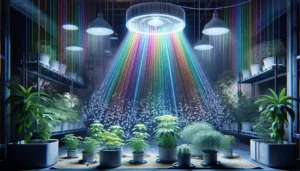
Understanding Photosynthetic Photon Flux (PPF)
Photosynthetic Photon Flux (PPF) is a term that, while technically dense, holds the key to unlocking the full potential of LED grow lights in indoor gardening and horticulture. Defined as the total amount of photosynthetically active radiation (PAR) emitted by a light source per second, PPF is measured in micromoles per second (umol/s). This metric is crucial for growers as it directly relates to the amount of light available for plant photosynthesis, the process by which plants convert light energy into chemical energy to fuel growth and development.
Why PPF Matters in Grow Lighting
In the context of indoor gardening, where sunlight is substituted or supplemented by artificial lighting, PPF becomes an essential measure of a light source’s capability to support plant life. It is not just the intensity of light that matters but the quality and spectrum of light within the PAR range (400-700 nanometers) that can be effectively utilized by plants. A higher PPF indicates a greater amount of usable light for photosynthesis, making it a key factor in selecting LED grow lights for any indoor cultivation setup.
The Role of PPF in Plant Growth
Plants require different light intensities and spectra at various stages of their growth cycle. For instance, blue light promotes vegetative growth, while red light encourages flowering and fruiting. By understanding PPF, growers can tailor their lighting systems to provide optimal light conditions throughout the plant lifecycle, enhancing growth rates, improving yield quality, and even controlling plant morphology.
Measuring and Interpreting PPF
PPF is determined by using specialized equipment that measures the number of photons emitted by a light source within the PAR range. However, it’s important to note that PPF does not account for the distribution of light over a specific area or how efficiently plants are able to use that light. This is where other metrics, such as PPFD (Photosynthetic Photon Flux Density), come into play, providing a more localized measure of the light that actually reaches the plant canopy.
Maximizing Efficiency with PPF
For indoor gardeners and commercial growers, maximizing the efficiency of their grow light setup involves not just selecting lights with a high PPF but also ensuring that the emitted light is directed and distributed evenly across the plant canopy. Reflective surfaces, proper light placement, and the use of light movers can all contribute to a more efficient use of light, reducing energy consumption and improving overall plant health.
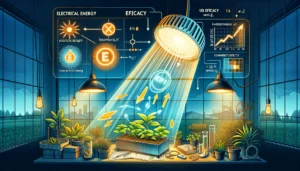
Efficacy in LED Grow Lights: umol/j Explained
In the quest to create the most efficient indoor growing environments, the efficacy of LED grow lights, measured in micromoles per joule (umol/j), emerges as a pivotal metric. This measure of efficacy provides insight into how effectively a grow light converts electrical energy into photosynthetically active radiation (PAR) — the spectrum of light used by plants for photosynthesis. Understanding and optimizing for high efficacy can lead to significant energy savings and enhanced plant growth, making it a crucial consideration for any indoor gardening setup.
What Does umol/j Mean?
Efficacy, expressed as umol/j, quantifies the amount of usable light produced per unit of electrical energy consumed. A higher value indicates a more efficient light, meaning more photosynthetic light is available for plants per watt of electricity used. This efficiency not only reduces operational costs but also minimizes the environmental impact of indoor growing operations by lowering energy consumption.
The Importance of High Efficacy
High-efficacy LED grow lights ensure that the majority of energy consumed is transformed into PAR, reducing waste heat and the need for additional cooling in the grow space. This directly translates to healthier plants and higher yields, as more of the light emitted by the grow lights can be used for photosynthesis. Additionally, lights with higher efficacy typically have a longer lifespan, further increasing their cost-effectiveness over time.
Comparing Efficacy Among Grow Lights
When selecting LED grow lights, it’s vital to compare their efficacy ratings. Lights with higher umol/j values are generally preferable, but it’s also important to consider the spectrum of light they emit and whether it aligns with the specific needs of the plants being grown. Some lights may offer exceptional efficacy but lack in spectral quality, highlighting the need for a balanced approach in light selection.
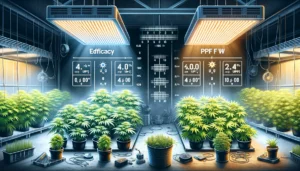
Optimizing for Efficacy
To maximize the benefits of high-efficacy lighting, growers should also consider factors such as light placement, the reflective properties of their grow space, and the distribution of light across the plant canopy. Optimizing these factors can enhance the effective use of light, ensuring that plants receive the right amount of PAR at the right stages of growth.
The efficacy of LED grow lights plays a critical role in the success of indoor gardening projects. By choosing high-efficacy lights and optimizing their use, growers can achieve more sustainable and productive operations. As technology advances, the efficacy of LED grow lights continues to improve, offering even greater opportunities for energy savings and enhanced plant growth in the future.
Comparing Efficacy (umol/j) and PPF (w) in LED Grow Lights
When navigating the complexities of LED grow light technology, understanding and comparing two pivotal metrics — efficacy (umol/j) and Photosynthetic Photon Flux (PPF, measured in watts) — is essential for any indoor grower aiming to optimize their plant growth environment. These metrics, while distinct, interplay to influence the overall performance of a grow light and, consequently, the health and productivity of plants under their illumination.
The Interplay Between Efficacy and PPF
Efficacy, defined as the amount of photosynthetically active radiation (PAR) produced per unit of electrical energy consumed, directly impacts the energy efficiency and cost-effectiveness of a grow light. Meanwhile, PPF measures the total amount of PAR that a light emits, offering a broad indicator of its potential to support plant photosynthesis.
A grow light with high efficacy but low PPF might not provide enough light for optimal plant growth, especially in larger setups. Conversely, a light with high PPF but lower efficacy may result in wasted energy and increased operational costs without proportionately benefiting plant growth.
Balancing Efficacy and PPF for Optimal Growth
Achieving the right balance between efficacy and PPF is crucial. High-efficacy, high-PPF lights represent the ideal, ensuring that plants receive ample light with minimal energy waste. This balance facilitates not only healthier and more productive plants but also contributes to sustainability by reducing the carbon footprint of indoor growing operations.
Impact on Plant Health and Yield
The influence of these metrics on plant health and yield cannot be overstated. Plants under optimal lighting conditions — characterized by a harmonious balance of high efficacy and PPF — tend to exhibit stronger vegetative growth, faster flowering times, and higher yields. This is because they receive the right amount of light in the most energy-efficient manner, closely mimicking the ideal conditions found in nature.
Choosing the Right LED Grow Light
When selecting an LED grow light, growers should consider both efficacy and PPF values in conjunction with their specific growing needs. Factors such as the size of the grow area, the types of plants being cultivated, and the stages of plant growth all play a role in determining the most suitable lighting solution.
Comparing and understanding the implications of efficacy (umol/j) and PPF (w) in LED grow lights is crucial for any indoor growing operation. By choosing a light that offers the best combination of these metrics, growers can ensure their plants thrive, achieving optimal growth and productivity. As LED technology continues to advance, the potential for even greater efficiency and effectiveness in grow lighting promises to further enhance the possibilities for indoor horticulture.
![]()
Practical Tips for Choosing LED Grow Lights Based on Efficacy and PPF
Selecting the right LED grow lights is a pivotal decision in the setup of any indoor gardening project. With the myriad of options available, understanding how to choose based on efficacy (umol/j) and PPF (w) values can be the difference between a thriving garden and one that just barely meets its potential. Here are practical tips to guide you through this process:
1. Assess Your Plant Requirements
Different plants have varying light needs. Consider the light intensity (PPF) and quality (spectrum) required for your plants at different growth stages. High-efficacy lights ensure that your plants receive the most usable light for their energy consumption.
2. Calculate Your Grow Space Size
The size of your grow space will determine the amount of light (PPF) needed to cover it adequately. Use the PPFD (Photosynthetic Photon Flux Density) metric to understand how light is distributed over a specific area and ensure that your chosen lights can provide consistent coverage across the entire canopy.
3. Compare Efficacy Ratings
Look for lights with high efficacy (umol/j) to ensure energy efficiency. Higher efficacy means more light output per unit of energy consumed, leading to lower electricity bills and a reduced environmental footprint.
4. Consider Light Spectrum Needs
While efficacy and PPF are critical, the spectrum of light is equally important. Ensure the light offers a full spectrum or one that matches the specific needs of your plants, enhancing growth, flowering, and fruiting.
5. Opt for Quality and Durability
Invest in lights from reputable manufacturers with proven performance and reliability. High-quality LED grow lights may come at a higher upfront cost but will save money and improve yields in the long run.
6. Look for Adjustable Features
Some LED grow lights offer adjustable spectrums or intensity. This flexibility can be invaluable, allowing you to tailor the light to your plants’ changing needs as they grow.
7. Read Reviews and Conduct Research
Before making a purchase, read reviews and research the experiences of other growers with the lights you’re considering. Their insights can help you avoid common pitfalls and select the best lights for your specific situation.
Choosing the right LED grow lights involves more than just picking the one with the highest PPF or efficacy rating. It requires a thoughtful consideration of your plants’ needs, your grow space, and the specific features of the lights. By following these practical tips and understanding the importance of efficacy (umol/j) and PPF (w), you can make an informed decision that ensures your indoor garden thrives.
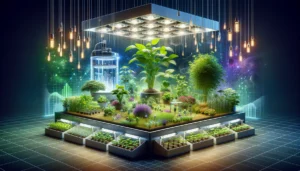
Conclusion: Lighting the Way Forward in Indoor Gardening
As we’ve explored the nuances of LED grow light technology, including the critical metrics of efficacy (umol/j) and Photosynthetic Photon Flux (PPF, measured in watts), it’s clear that understanding these terms is not just beneficial but essential for anyone involved in indoor gardening or commercial horticulture. These metrics serve as the cornerstone for selecting grow lights that not only optimize plant health and yield but also ensure energy efficiency and sustainability.
Choosing the right LED grow lights is a nuanced decision that balances efficacy, PPF, spectrum, and other factors to meet the specific needs of your plants and grow space. By prioritizing lights that offer the best combination of these features, growers can maximize their investment and witness the profound impact of optimized lighting on plant growth.
As LED technology continues to evolve, the future of indoor gardening looks bright. Innovations in light efficacy and spectrum offer promising avenues for further enhancing plant growth, reducing energy consumption, and making indoor agriculture more accessible and productive. Armed with the knowledge of efficacy and PPF, growers are better equipped to navigate this evolving landscape, making informed decisions that pave the way for a greener, more fruitful future.
In the end, the journey through understanding LED grow lights illuminates much more than our indoor gardens; it sheds light on the art and science of growing itself, revealing that with the right knowledge and tools, we can cultivate not just plants, but a deeper connection to the cycle of life they represent.